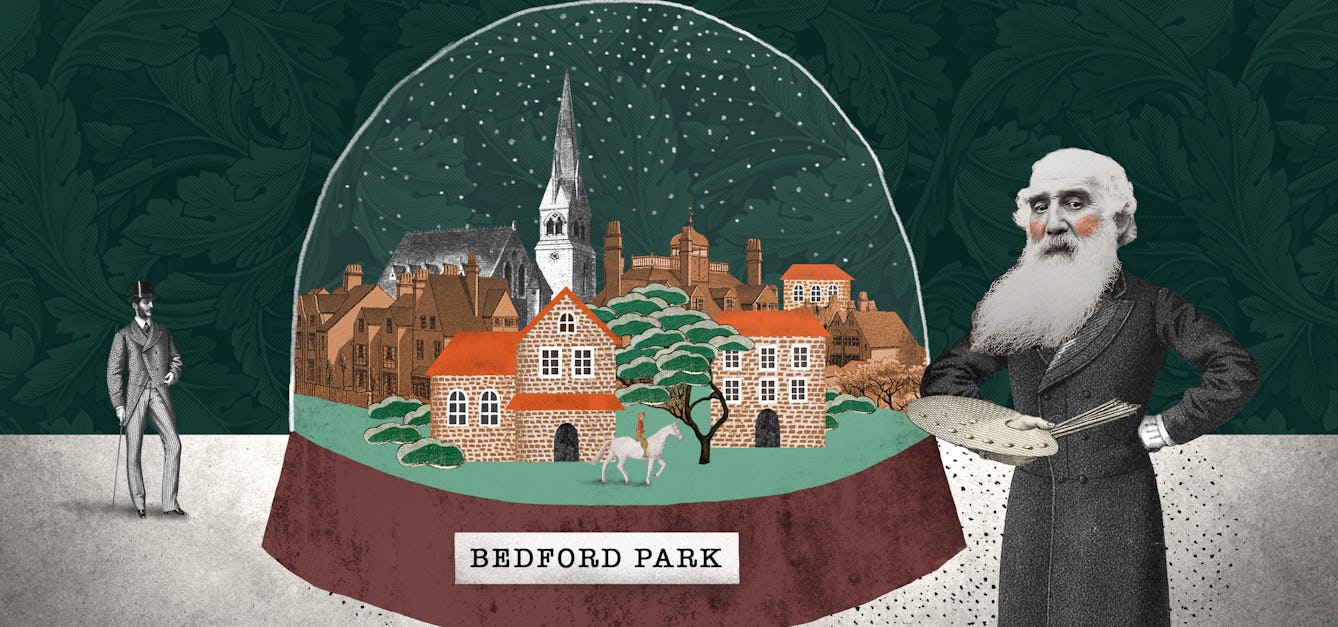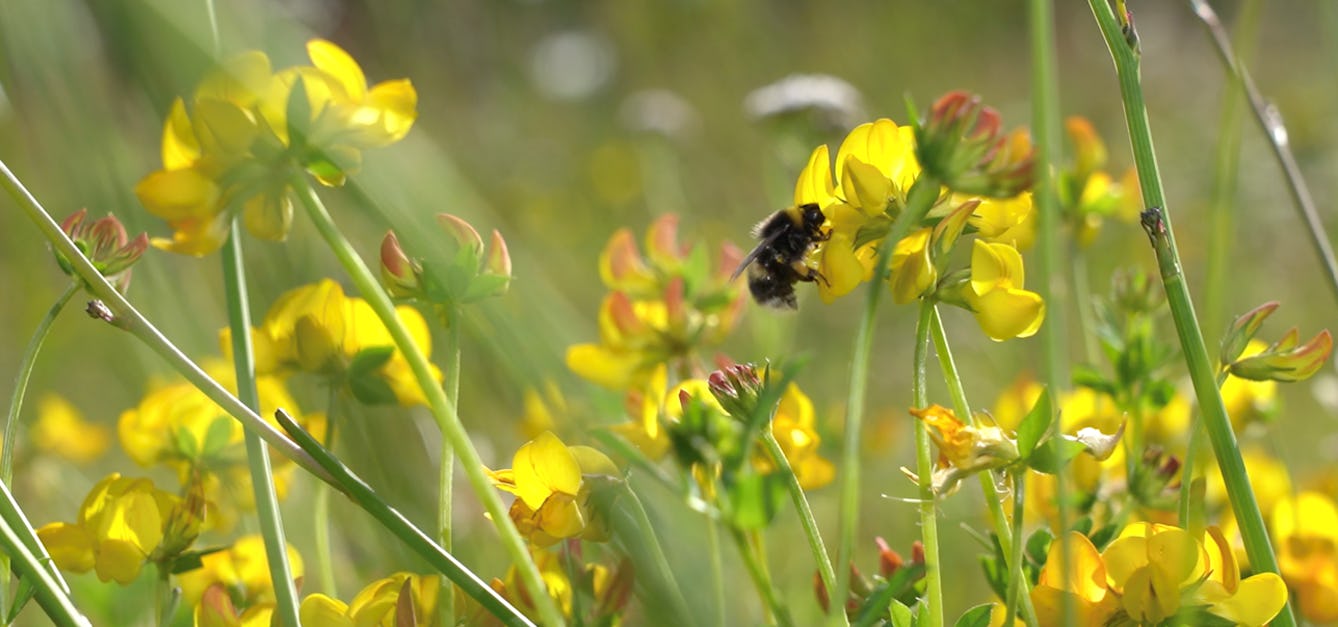Stories

- Article
Building a dream in the garden suburbs
In the late 19th century a ‘garden suburb’ promised a retreat from London’s dirt and crowds. See how this new concept was developed to appeal to the health concerns of the literary classes.

- Article
Plant portraits
The beautiful and mysterious illustrations in medieval herbals convey a wealth of knowledge about the plants they portray.

- Book extract
Ayurveda: Knowledge for long life
The story of medicine in India is rich and complex. Aarathi Prasad investigates how it came to be this way.

- Book extract
What the wind can bring
In this extract from ‘This Book is a Plant’, Amanda Thomson shares a newfound fascination with flowers, and reveals why our relationship with plants can also be complicated.
Catalogue
- Archives and manuscripts
- Online
Sketches of the Retreat buildings and grounds by H.G. Hampton
Date: 1925Reference: RET/2/1/22/5Part of: The Retreat Archive- Pictures
St John's College, Cambridge: New Court from the backs. Line engraving by J. Le Keux, 1840, after F. Mackenzie.
Mackenzie, Frederick, 1787 or 1788-1854.Date: 1 October 1840Reference: 16122i
- Pictures
- Online
The North London Hospital for Consumption and Diseases of the Chest: elevation view of the garden facade with balconies indicated, people walking among trees at ground level. Process print by Sprague & Co., ca.1879, after A. Howard.
Howard, A., active 1879.Reference: 21689i
- Pictures
- Online
Lansdowne college and surrounding grounds, Bath. Wood engraving by W.E. Hodgkin, 1858, after J. Wilson.
Hodgkin, W. E., active 1853-1879.Date: 1858Reference: 15505i
- Pictures
The County Lunatic Asylum, Brentwood, Essex: bird's eye view. Wood engraving by W.E. Hodgkin, 1857, after H.E. Kendall.
Hodgkin, W. E., active 1853-1879.Date: 16 May 1857Reference: 15653i
![Papaver somniferum L. Papaveraceae Opium Poppy Distribution: Asia minor, but has been dated to 5000BC in Spanish caves. Now grows almost everywhere. The oldest medicine in continuous use, described in the Ebers' papyrus (1550 BC), called Meconium, Laudanum, Paregoric and syrup of poppies. Culpeper (1650) on Meconium '...the juyce of English Poppies boyled till it be thick' and 'I am of the opinion that Opium is nothing else but the juyce of poppies growing in hotter countries, for such Opium as Authors talk of comes from Utopia.[he means an imaginary land, I suspect]’]. He cautions 'Syrups of Poppies provoke sleep, but in that I desire they may be used with a great deal of caution and wariness...' and warns in particular about giving syrup of poppies to children to get them to sleep. The alkaloids in the sap include: Morphine 12% - affects ?-opioid receptors in the brain and causes happiness, sleepiness, pain relief, suppresses cough and causes constipation. Codeine 3% – mild opiate actions – converted to morphine in the body. Papaverine, relaxes smooth muscle spasm in arteries of heart and brain, and also for intestinal spasm, migraine and erectile dysfunction. Not analgesic. Thebaine mildly analgesic, stimulatory, is made into oxycodone and oxymorphone which are analgesics, and naloxone for treatment of opiate overdose – ?-opioid receptor competitive antagonist – it displaces morphine from ?-opioid receptors, and constipation caused by opiates. Protopine – analgesic, antihistamine so relieves pain of inflammation. Noscapine – anti-tussive (anti-cough). In 2006 the world production of opium was 6,610 metric tons, in 1906 it was over 30,000 tons when 25% of Chinese males were regular users. The Opium wars of the end of the 19th century were caused by Britain selling huge quantities of Opium to China to restore the balance of payments deficit. Laudanum: 10mg of morphine (as opium) per ml. Paregoric: camphorated opium tincture. 0.4mg morphine per ml. Gee’s Linctus: up to 60 mg in a bottle. J Collis Browne’s chlorodyne: cannabis, morphine, alcohol etc. Kaolin and Morph. - up to 60 mg in a bottle. Dover’s Powders – contained Ipecacuana and morphine. Heroin is made from morphine, but converted back into morphine in the body (Oakeley, 2012). One gram of poppy seeds contains 0.250mgm of morphine, and while one poppy seed bagel will make a urine test positive for morphine for a week, one would need 30-40 bagels to have any discernible effect. Photographed in the Medicinal Garden of the Royal College of Physicians, London.](https://iiif.wellcomecollection.org/image/B0009101/full/282%2C/0/default.jpg)
![Papaver somniferum L. Papaveraceae Opium Poppy Distribution: Asia minor, but has been dated to 5000BC in Spanish caves. Now grows almost everywhere. The oldest medicine in continuous use, described in the Ebers' papyrus (1550 BC), called Meconium, Laudanum, Paregoric and syrup of poppies. Culpeper (1650) on Meconium '...the juyce of English Poppies boyled till it be thick' and 'I am of the opinion that Opium is nothing else but the juyce of poppies growing in hotter countries, for such Opium as Authors talk of comes from Utopia [he means an imaginary land, I suspect]’. He cautions 'Syrups of Poppies provoke sleep, but in that I desire they may be used with a great deal of caution and wariness...' and warns in particular about giving syrup of poppies to children to get them to sleep. The alkaloids in the sap include: Morphine 12% - affects ?-opioid receptors in the brain and causes happiness, sleepiness, pain relief, suppresses cough and causes constipation. Codeine 3% – mild opiate actions – converted to morphine in the body. Papaverine, relaxes smooth muscle spasm in arteries of heart and brain, and also for intestinal spasm, migraine and erectile dysfunction. Not analgesic. Thebaine mildly analgesic, stimulatory, is made into oxycodone and oxymorphone which are analgesics, and naloxone for treatment of opiate overdose – ?-opioid receptor competitive antagonist – it displaces morphine from ?-opioid receptors, and reverses the constipation caused by opiates. Protopine – analgesic, antihistamine so relieves pain of inflammation. Noscapine – anti-tussive (anti-cough). In 2006 the world production of opium was 6,610 metric tons, in 1906 it was over 30,000 tons when 25% of Chinese males were regular users. The Opium wars of the end of the 19th century were caused by Britain selling huge quantities of Opium to China to restore the balance of payments deficit. Laudanum: 10mg of morphine (as opium) per ml. Paregoric: camphorated opium tincture. 0.4mg morphine per ml. Gee’s Linctus: up to 60 mg in a bottle. J Collis Browne’s chlorodyne: cannabis, morphine, alcohol etc. Kaolin and Morph. - up to 60 mg in a bottle. Dover’s Powders – contained Ipecacuana and morphine. Heroin is made from morphine, but converted back into morphine in the body (Oakeley, 2012). One gram of poppy seeds contains 0.250mgm of morphine, and while one poppy seed bagel will make a urine test positive for morphine for a week, one would need 30-40 bagels to have any discernible effect. Photographed in the Medicinal Garden of the Royal College of Physicians, London.](https://iiif.wellcomecollection.org/image/B0009102/full/282%2C/0/default.jpg)


